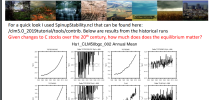I'm posting a problem experienced by a user on Bluefire to see if other users have had a similar experience. We've tried unsuccessfully to uncover something wrong, such as bad atmosphere data or bad initialization. Has this come up for others? If so, have you solved it somehow?
Thank you,
Sam Levis
Message written by clm user:
I did a spinup following the description in chapter 4 in the manual. I use the ICN compset and the same resolution as in the manual. I first ran it for 600 y in accelerated spinup mode, then 1 y in exit spinup and then first 50 y in normal mode, but as it was not in equilibrium, and communications with you and other suggested that longer runs were necessary, I continued for 1350 more years.
The problem is that shortly after the start of the normal run, NPP decreases quickly in tropical areas (reaches zero in less than 10 y, these results are in the CN_finalspinup/lnd/hist folder). In some areas it recovers later in the simulation, but in Amazon it does not, and it ends up with no NPP or carbon in any pool at the end of the simulation. I have not changed anything in the code.
Thank you,
Sam Levis
Message written by clm user:
I did a spinup following the description in chapter 4 in the manual. I use the ICN compset and the same resolution as in the manual. I first ran it for 600 y in accelerated spinup mode, then 1 y in exit spinup and then first 50 y in normal mode, but as it was not in equilibrium, and communications with you and other suggested that longer runs were necessary, I continued for 1350 more years.
The problem is that shortly after the start of the normal run, NPP decreases quickly in tropical areas (reaches zero in less than 10 y, these results are in the CN_finalspinup/lnd/hist folder). In some areas it recovers later in the simulation, but in Amazon it does not, and it ends up with no NPP or carbon in any pool at the end of the simulation. I have not changed anything in the code.

